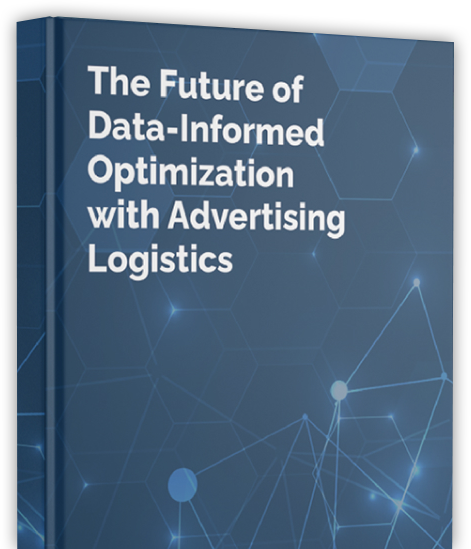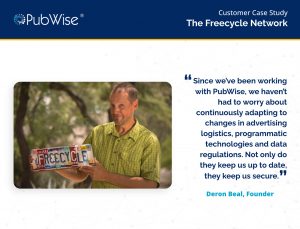Description
Just as the sports industry has tipsters that offer betting advice, AdTech has a slew of trade pubs that each have their opinion on the post-third-party-cookie world. In this episode, Stephen dives into some of the different approaches featured in the news lately. He believes that in the future, audience size will not be the proxy to value; having an identifiable and addressable audience that your demand partners value will be the gateway to building strong partnerships that will survive the test of time. With less than a year until the end of third-party cookies in Chrome, the race is on to figure out how to redefine monetization.
Transcript
Tony Winders: Hello, and welcome to another edition of On the SPOT. I’m Tony Winders. And today I’m putting PubWise Founder and CTO Stephen Johnston On the SPOT about recent industry news related to first-party data and how the industry is preparing for a world without third-party identifiers. Really looking forward to the conversation, Stephen, great to speak with you again.
Stephen Johnston: Good to talk to you.
Tony Winders: So you and I were looking at a few articles together, we share news back and forth day-to-day. And there were a few articles that we’ve seen in AdExchanger, TechCrunch and Digiday in the recent past about how the world is adapting to this post-cookie environment that everyone’s anticipating. I want to talk a little bit about what we’re seeing in the news and use this as an opportunity to get your perspective and to share with publishers and others in our audience about what’s going to happen next. Because we’ve talked about this before, you even said this is going to evolve, people are going to have different experimental approaches to what comes next and now we’re seeing some of these emerge. So I’m eager to talk to you about some of these articles that we’ve been talking about.
Stephen Johnston: Part of the conversation is, let’s understand what it means to “remove cookies” which is often the phrase used, we’re really talking about removing third-party cookies. And that is the method by which a whole bunch of demand side platforms have acquired identity information, and interest information and audience information across a bunch of sites and a bunch of audiences. When we talk about cookies going away, we’re talking about that easy source of that information going away. What I’ve been saying is, that the value and the control is going to shift back to publishers, because they’re the ones who have that data. And if you can’t get an easy third-party cookie to share between them all, then you have to get it from the publisher. The flip side of that is, some of these articles talked about, well, if you’re a really, really big publisher, then you’ve got a bunch of your own first-party data. And that’s where this term ”walled garden” comes from. If you’ve got a big enough set, we don’t just call it a publisher’s first-party data that becomes a walled garden, and because it’s big enough that you can do a lot of the activity inside of your own sphere.
Tony Winders: Yeah, one of these articles that we traded messages about was by Alyssa Boyle at AdExchanger. And the title of it is, “Goodbye Cookies, Hello Identity Walled Garden”. So in it, I think she’s referring to exactly what you’re talking about, which is publishers themselves becoming their own walled garden. Whereas I think of walled gardens as like Facebook, AOL, or big, big, scalable behemoths. But she’s talking about The Financial Times, which of course, is a big publisher, but are you saying that individual publishers are going to become their own walled garden?
Stephen Johnston: I think I understand the point of the article here in terms of I think the walled garden is sort of a misnomer. It’s been used some as a pejorative to say, it’s solely owned, you don’t share it. But any conversation around a first-party is, why would you share it without some exchange of value? All publishers should be trying to figure out how to wall their garden. You don’t spend all your time growing vegetables so that the neighbors can just come over and pick it clean. And I think that’s basically what’s been done to publishers this whole time, through third-party cookies is, the moment you share that audience data through some sort of uncontrolled means it gets added to a pool and gets reused by 1000 different people and many, many campaigns beyond whatever the initial exchange of value was. That’s why we’ve had conversations about cookie syncing and when you sync and whether you can sync before you deliver an ad and all these things are all related to this question. So if a company has a really large pool of data, and they found a way to control its flow, then that is a walled garden, but I think publishers going forward should be looking for ways to surface their data and how to control it. It’s a good thing if you’re able to build a bit of a wall around it, and I would take that out of the negative and into the positive. A walled garden means that you are able to control the value exchange of that data and understand how it gets transacted on a going forward basis. I think every publisher should be looking to do it, they better have started already, and they sure as heck better be starting now.
Tony Winders: Alyssa also references seller-defined audiences. Is that partly what you’re referring to?
Stephen Johnston: We can tell you first-party data, right? First-party data, first-party data. Well, what is it and how do you leverage it? How do you package that and push it back out so that other people can see its value and see that audience value and buy it? And so seller-defined audiences is one of the ways to do that, its an IAB spec, basically, it’s the seller saying, “I know the types of audiences that are out there that are valuable to the demand side, and I can get signals from my first-party data to put people into these buckets. And then I can communicate that out to the demand side.” And there’s just some particulars to do it. We previously essentially had a third-party demand side platform to find audiences. And that was activated by the third-party cookie. So, the seller-defined audience is first-party data activated audiences.
Tony Winders: Good explanation, thank you. The other article that we talked about, and speaking of walled gardens, was this TechCrunch article by Natasha Lomas, that said,”Uh oh! European carriers are trying to get into ‘personalized’ ad targeting”. So this also seems like a really clever attempt by European telcos to create their own walled garden because they are big, scalable, first-party collectors of data. What do you read into that piece?
Stephen Johnston: I certainly do not fault them for testing this. I think that in general, privacy regulation, the sensibility of what does it means to be a carrier or what does it means to be an infrastructure layer, is a real challenge in terms of allowing that infrastructure layer to collect and monetize data about what’s transpiring on it. We don’t often think about it this way, but imagine if you picked up the phone, and you called a business partner, and your phone company was listening in, saw that you were transacting on widgets, and then said, “You know what we should do, we should get into the widget business.” I think that’s a bit of what’s happening here. They’re listening in on the market, they’re extracting value from it, and they’re going to package that back up in order to sell it in their own way. And they’re trying to say it’s first-party data, because they’re the infrastructure layer that carried it. That sounds like a bit of hooey to me. I think it’s not going to pass privacy regulation, but I completely understand why they’re doing it. And I think this has been part of the conversation, that there’s going to be a lot of these attempts. In the interim, I would be asking the question as a publisher of, how do I get value out of that? Is there a way for me to partner with these guys and get paid for it? Is there a way to participate in that transaction instead of just providing them information? That’s the pragmatic approach. I think there’s going to be a lot of challenges here that I think in general, we should be asking, do you want Windows listening in on everything you’re doing on your computer? Would you want your data center to track all the stuff that’s going between your machines and then building stuff? Do you want the phone company listening in and then competing with you? And if we would say no to all those things, then why are we saying it’s okay for an infrastructure layer, on the phone side, just because it’s the new way to do it? Why are we comfortable with that? We’ll see how that evolves. There’s been a couple of other attempts at this, Comcast tried some things like this, they got knocked down, it’s not much different than saying, “We’re gonna listen in to all the internet chatter, and then resell audiences,” but it’s had various levels of success.
Tony Winders: The other article that we were discussing was from Digiday and the title was “On the Cannes Croisette, publishers put their best foot forward as industry hurtles toward the unknown.” So I think this is a great piece to talk about, because as you said, publishers need to be thinking about what’s next and preparing for the future. And I think the future is still somewhat unknown. But we’re starting to see different approaches emerge and different ways of thinking about the use of first-party data, but anything that you read into this article that would have clues as to what publishers should be thinking about next?
Stephen Johnston: Yeah, I think it drives home the idea that the reliance on the third-party cookie was the high fructose corn syrup for the whole industry, I’ve said it’s high fructose corn syrup for buyers. But it was the easy way for publishers too. You drop some cookies, you make the transactions happen, third-party cookies glue it all together with an identity layer or an audience layer or whatever sort of element you’re plugging into on the buy side to see where the value is, that’s going to go away. I think a couple of things are going to happen that publishers need to absolutely be aware of are the idea that you can build a site that merely flushes the audience through pages, and shows them ads and relies on third-party matching to monetize and inventory, is dead. Now is that three months, six months, a year? I don’t know. That business model is dead in the future. If all you’re doing is traffic arbitrage, pack up now. Because without the exposure of your own data, without collecting data beyond this, “Well, they were interested in which celebrity had a nose job,” doesn’t tell you a whole lot about what someone wants to buy. Looking at a list of the best dresses at the Oscars, doesn’t mean a person wants some high fashion dress, it doesn’t tell you anything about the audience, well maybe a little bit. It’s not not the best actionable data. And so this article is talking about a couple of different elements of what’s happening with first-party data? How do you surface it? How do you push it through the system? It talks about the value flowing back to the publisher, but that publisher has to be valuable, that publisher has to have valuable information about the audience so that it can surface it back up through seller-defined audiences or build their own walled garden. Let’s champion that as a good term, build your own damn walled garden, fueled with your first-party data. Just relying on third-party cookies to make all that happen through some sort of magic, publishers with good audiences that are their audiences or interacting with things that give signal about interests, or they can find ways to collect that signal whether it’s interesting products to figure out what a person is interested in so that they can create those audiences, are going to see a lot more value. My hope is that it drives up CPMs because now you’re getting a smaller, more focused audience, you’re going to be focused on the publishers who can deliver that insight, and their CPMs will go up, while the pure, audience pumping side of the industry crashes. There’s still going to be plenty of money out there, it’s just going to have to go to the places where you can identify a valuable audience.
Tony Winders: There are a few little tidbits here that I want to call attention to like more face to face meetings between advertisers and publishers directly. Publishers telling marketers we can provide you with audiences built from their own consented data, the fact that there are fewer ways for ad tech vendors to access that data means they have to change their act. They’re moving from being monetization first businesses, to facilitators of addressability. I think that bodes so well for what you’re building and PubWise.
Stephen Johnston: We want to be in a position to help a publisher provide this information, understand this value, understand the value exchange, leverage these things that are coming about, like seller-defined audiences, but then some other industry has got some other thing. So we’re at this inflection point, and this article is a little negative in tone in terms of, going towards the unknown. Adventure is the unknown. It’s the old saw of, you can either see it as a problem or an opportunity. The opportunity here is that there’s going to be a major shift in how the value is created. And it very much seems to be leaning towards the publisher. So get focused on doing the things that let you extract that value and that is first-party data.
Tony Winders: What do you say to smaller publishers that don’t really have a scalable audience? How can they play in this world that we’re headed toward?
Stephen Johnston: You didn’t get the value of the third-party data from your small audience, either. Everyone else did. If you have a small audience, let’s say it’s 0.1% of the industry, but it was niche. You got value only when they were on your site. And the fact that that was a niche audience through third-party cookies, allowed other people to target that same audience on all the stupid high fashion, who’s best dressed on the runway and the “10 best things” articles that we know are just pumping traffic through with that same niche audience as a third-party cookie, then lets someone else extract value from that audience, without giving you anything, we still run the risk of that in first-party data. And there’s initiatives around how we really identify where the data came from and give continuing value back to the originator of it. The balance of that shifts back to the publisher. If those other sites can’t monetize that audience, then your audience that is that niche and it’s identifiable, will become more valuable. So I don’t think size is the equalizer here, size is the proxy for value in third-party cookie land, the ability to target and address is the proxy of value in first-party cookie land or first-party data lands. And the reason is, you can’t just cookie them and follow them around the web, wherever they go, not as easily. Those niche sites that are sharing that audience are going to start to see increased value of their inventory. I think it’s a good thing. I think this is a good time to have a niche audience and I mean niche, and not that it’s small and minor, I’m saying identifiable, addressable, and valuable to demand. Which had some challenges as third-party blew up, it’s like you’re going to third-party cookie them, they’re going to just run around the web, I’ll get one impression out of the 100 or 1000 that they generated a day. If that audience is now only really addressable on those smaller niche sites, think of the financials, if you really only know they’re doing something financial related, and you’re on his niche sites, then the value of those sites goes up to the demand side.
Tony Winders: Will marketers only be able to target those audiences on those niche sites, or is there a way that you can actually take that first-party data and package it in a more scalable way?
Stephen Johnston: There are ways. There are some challenges in measurement that need to be cracked. There are ways but it’s more about, can it be defined and pooled across multiple sites? Then can we do some augmentation, the scale of it is just never going to reach the third-party scale, it’s never going to get there.
Tony Winders: Are you familiar with LiveRamp and their ability to anonymize audiences? Do they have a role in this? Or are they dead because third-party cookies are their stock and trade? Do you happen to have an opinion about that?
Stephen Johnston: Well, I mean, they’ve got solutions that aren’t third-party cookies. I wouldn’t say they’re dead. I think they’re a component of it. They require a login, there’s a whole bunch of sites that don’t have a login at all for at least part of their solution. And I’m sort of oversimplifying what they do, they absolutely have a role to play. Part of the way to think about this is, it used to be that we just relied on the third-party cookie, and it did all the work. There’s got to be a host of solutions, they’re going to work better for one publisher versus another. That’s why we’re building systems that monitor all this and provide observability about it, because one publisher is going to find that these three work, and one’s going to find another three work, I think you’re less likely to say that there’s just one go-to. Clearly in the next two years, that isn’t the right answer.
Tony Winders: Well, I didn’t mean to put you On the SPOT, except that that’s the name of the podcast. I appreciate you fielding that answer, along with all of them. Stephen, this has been great. And we’ll share links to these three articles that we’ve been talking about with the recording, but I’ve really appreciated the dialogue and the feedback on this industry perspective of the demise of the third-party cookie and what we need to be thinking about as publishers and the industry moving forward.
Stephen Johnston: The data opportunity, the first-party opportunity, that’s where we’re at.
Tony Winders: Exactly, not a cookie apocalypse, but rather a first-party data opportunity. Stephen, thanks again. This has been On the SPOT with Stephen Johnston, CTO and Founder of PubWise, always a pleasure.





